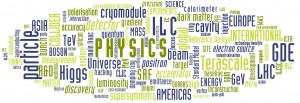
Content will now be tagged. The tags used with higher frequency will appear inside a weekly updated tag cloud at the bottom of the left sidebar. Tags will make easier browsing for related content.
Welcome to the new ILC NewsLine! This is the first issue of a new style, with a modern look and feel, new logo, more cohesive page design and navigation, wider format, larger images and added features and functionalities. Since 2005, ILC NewsLine has been our main tool for communicating the continuous progress of our ILC community. The content is directed at our audience that typically has interest and familiarity with particle physics and the ILC. Therefore, we do not shy away from including some technical and scientific content in our articles. In fact, we try to balance covering scientific, political and personal issues that we feel have relevance to our audience. It is quite a challenge to make an interesting and timely issue weekly, especially considering that it is a global publication, where the content, our communicators and our readership are all distributed around the world.
Today we are proud to introduce the new stylish design of ILC NewsLine, which was capably created by Xeno Media, the Chicago company that designed all the previous versions of our newsletter.
Among the new features is the new commenting function, tag cloud, sharing and social bookmarking, and Really Simple Syndication (RSS) feed of individual stories. In particular, we encourage you to directly interact and express your opinions by adding comments to our published stories or participate in discussions via the comment system. You can also share stories to several popular social networks. We have moved away from the classic three-column layout in order to make the homepage more inviting to read, by making it wider and displaying a short summary of each story along with the headline and thumbnail image. Regardless of how old the page is that you are currently visiting, the left sidebar will dynamically display the most recent table of contents, most popular tags, latest updates and upcoming ILC related events all at a glance.
Behind the scenes, the new system is set up in a way that our writers can directly draft and edit their stories at any time prior publication. ILC Newsline is a ‘global’ publication, edited across the oceans, so this represents a major advantage. Another benefit of this system is that the content will be indexed, resulting in an improved and more precise internal search. At the same time, the new syntax of the page addresses (URLs) – besides being easier to read and to remember – will also optimise the way ILC NewsLine content is indexed by external search engines. In addition, we improved the archive, providing output lists by author, category and tag. Look for the tags at the end of each story and click on them to view related content we published in the past.
The new format is optimised for web browser viewing; however, we will still send our subscribers the newsletter in email format. Since many of our readers and collaborators travel and access ILC NewsLine from their smartphones, images will not be embedded anymore in the email version delivered to your Inbox. To visualise remote images, blocked by default by most email readers, you will have to explicitly allow your email client to ‘load images’ from the ILC NewsLine site. Alternatively, you can download the pdf version of the full issue, including main page and all stories, and read it offline.
We also enhanced the subscription management: in order to be added to the NewsLine distribution list, new subscribers will be required to respond to the confirmation email. No action is required for existing subscribers. Should you want to unsubscribe, simply select the unsubscribe link at the bottom of the NewsLine email.
This has been a collaborative and global effort, as usually happens in the ILC community.
First of all, we want to thank the ILC communicators for setting together with us the requirements for this project and for providing original ideas, such as the adoption of the commenting and sharing functions. They also gave us several suggestions to make the design more appealing and the navigation more intuitive.
Particular acknowledgment is due to the two young ILC Global Design Effort members and brilliant software developers who worked on this makeover project since the beginning: David Seigle and Kevin Flannery. They have been capably and restlessly transforming ideas into coded (and working!) software. Last summer David developed the core of this new system, the general purpose plug-in for newsletters editing and publishing. Kevin has since developed the NewsLine customisations, with meticulous care and attention paid to the minutest detail. Kevin has also provided an essential contribution with the system configuration and maintenance and with the archiving of all the legacy content.
We hope you will enjoy the renewed ILC NewsLine, and find it not only more visually appealing, but also more inviting to read, browse and worth sharing with colleagues and friends. Don’t forget to bookmark the new address: https://newsline.linearcollider.org (the old address will also work).
If you are not a subscriber yet, we invite you to sign up to our weekly ILC newsletter!



CONGRATS!!!